The Italian Renaissance was a cultural movement that aimed to bring back the light of classical knowledge after the darkness of the Middle Ages.
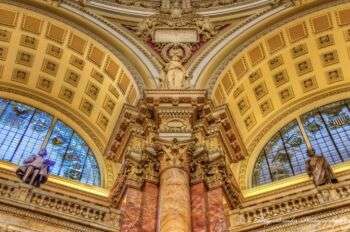
Image source: https://search.creativecommons.org/photos/f447bc73-b420-41ca-bb39-c248bbb5ecbc by yeahbouyee
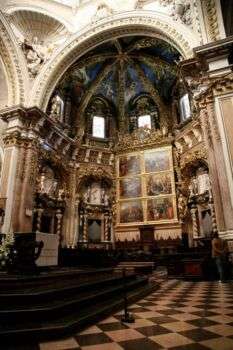
Image source: https://search.creativecommons.org/photos/2dfaa903-3b4a-4dc7-89a4-cbd9a0d43a04 by (vincent desjardins)
Renaissance Architecture
Brunelleschi’s first commission was for the dome that covered the central space of Florence’s cathedral, designed by Arnolfo di Cambio in the 14th century without a roof. Brunelleschi’s daring design used the pointed Gothic arch and Gothic ribs that were conceived by Arnolfo. While stylistically this structure is Gothic, the roof is structurally influenced by Ancient Rome, which Brunelleschi could not have ignored during construction.
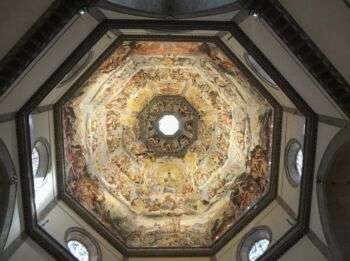
Image source: https://search.creativecommons.org/photos/66a57411-5f7c-4a8b-b844-79eb3785806e by tpholland
Inside the Pantheon‘s single-shell concrete dome is a coffering, which lightens the weight. The vertical partitions of the coffering are used as ribs. At the apex, there is an 8-meter opening. Brunelleschi knew that a huge dome could be designed without a keystone. Yet, the dome in Florence is supported by ribs and internally by a brick shell. Although the techniques are different, both domes have a thick network of ribs. The structures have a big opening at the top too.
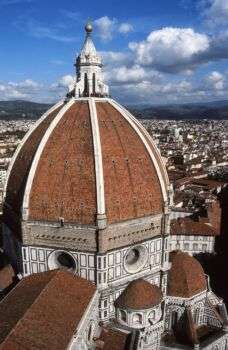
Image source: https://search.creativecommons.org/photos/80c0ebb5-d803-4f5a-91ae-8065de27bab3 by roy.luck
High Renaissance
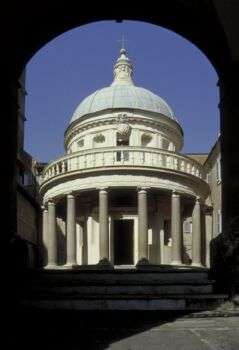
Image source: https://search.creativecommons.org/photos/6bb143eb-a235-4c7d-b464-b9a4db481a18 by MCAD Library
In Rome, Bramante designed the Tempietto in the Cloister of San Pietro in Montorio. This small circular temple was built where St Peter was martyred and is one of the most sacred sites in Rome. The temple has various architectural inspirations from Roman and Greek cultures. Its beauty and harmony were quickly praised by Giorgio Vasari, one of the most important critics of the time.
San Giorgio Maggiore , located in Venice, has four three-quarter composite columns based on high pedestals, which shaped the central door. In the back plane, the lower body of the church is structured with a small order of pilasters, used to support two lower half pediments on each side. The cornice line goes all over the central body and links the two forms.
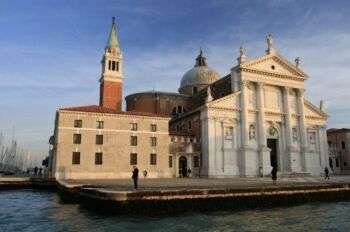
Image source: https://search.creativecommons.org/photos/2fff290a-8383-4ec1-876c-3b90b17f38ef by TravelingOtter
Renaissance Interior design
The interiors were also an important center of interest to Renaissance sensibility. Palaces were impressed with several spatial effects, such as marble staircases, and impressing decors. Living rooms and bedrooms were furnished with expensive pieces of furniture and designed respecting the spirit of antiquity. The floor, walls, and door lines were adorned with marble or ceilings trimmed with wood.

Image source: https://search.creativecommons.org/photos/c24584e3-04a9-424c-82e0-b2d3f9d77126 by KairosPhotography
The Renaissance also impacted furniture, which began incorporating several clear architectural elements, such as a miniature palace with columns, pilasters, cornices, pediments. The main materials used were black and white woods (oak, walnut), ivory, stone, marble, and sandstone. As for colors, dark and gloomy colors were mostly used along with cool shades of white and pastel shades to offer a sense of comfort.

Image source:https://search.creativecommons.org/photos/8df5e515-f705-4b3d-a517-6144f35bebf1 by Incase.
David by Donatello and Sculpture
David by Donatello marks the return of the nude sculpture in the round figure. Cosimo de Medici commissioned it for the Palazzo Medici. David is depicted in a triumphal moment of the bible when he won his battle with the Philistine, Goliath. Donatello seems to recall to mind heroic nudity of antiquity. A Renaissance sculpture usually has these features:
- Naturalism is evident in the use of contemporary subjects and naturalistic use of proportions
- The reemergence of classical subjects and forms passes through a revival of classicism in sculpture
- The craft of metalwork played a key role starting with bronze, employed first for reliefs, statues, and busts
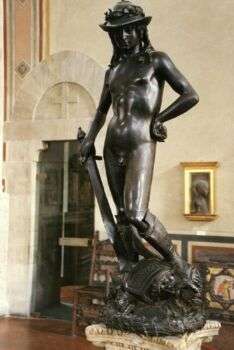
Image source: https://search.creativecommons.org/photos/1218661f-ff2c-4bf1-9dcd-d2e51622c6b2 by WVJazzman
Renaissance Art
Renaissance art can be divided into two periods:
Early Renaissance (1400-1479) in which artists learned trying to emulate classical artists giving importance to symmetry to produce the perfect form. Artists of this period were: Giotto, Masaccio, and Donatello.
High Renaissance (1475-1525) was featured with a rising interest in perspective and space to make art more realistic. Artists like Michelangelo, Leonardo da Vinci, and Rafael were important in this period.

Image source: https://search.creativecommons.org/photos/8e2cc574-7483-487f-9b0f-8a740f45861b by dalbera
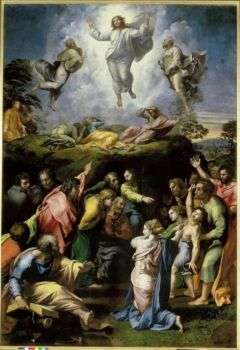
Image source: https://search.creativecommons.org/photos/f3d9a2bf-0aec-4858-bdc0-f3d121647abb by Institutnationaldhistoiredelart
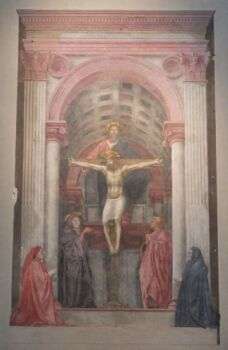
Image source: https://search.creativecommons.org/photos/1e48d15c-1a60-470d-b22e-a8ccccbf3f79 by tpholland
The main artist active during this time was Masaccio, who was famous for his frescoes of the Trinity in the Church of Santa Maria Novella and the Brancacci Chapel of Santa Maria del Carmine, in Florence. Masaccio painted for less than six years but was an important influence on the early Renaissance for the intellectualism and naturalism of his works.
Renaissance Artists Heritage
Rome displaced Florence as the most important center of Renaissance art. Three great artists, Leonardo da Vinci, Michelangelo, and Raphael, dominated the High Renaissance. Leonardo was even named the “Renaissance man” because of his interest in humanist and classical values. Leonardo’s best-known works, including the “Mona Lisa,” “The Virgin of the Rocks,” and “The Last Supper,” demonstrate his skill at rendering light, shadows and landscapes around human life.

Image source: https://search.creativecommons.org/photos/62c90106-5880-4a37-900e-92adcc3f6dc5 by Joaquín Martínez Rosado

Image source: https://search.creativecommons.org/photos/ab05b13d-b62b-4f65-b6e2-c31f34f1b93a by ideacreamanuelaPps
Info sources:
http://www.atlasobscura.com/places/tempietto-at-san-pietro-in-montorio
http://www.visual-arts-cork.com/sculpture/renaissance.htm
http://www.italianrenaissance.org/donatellos-david/
